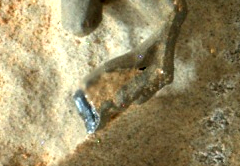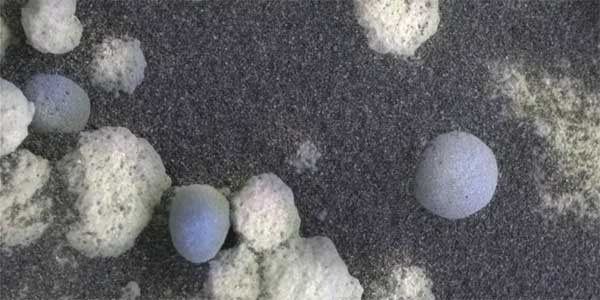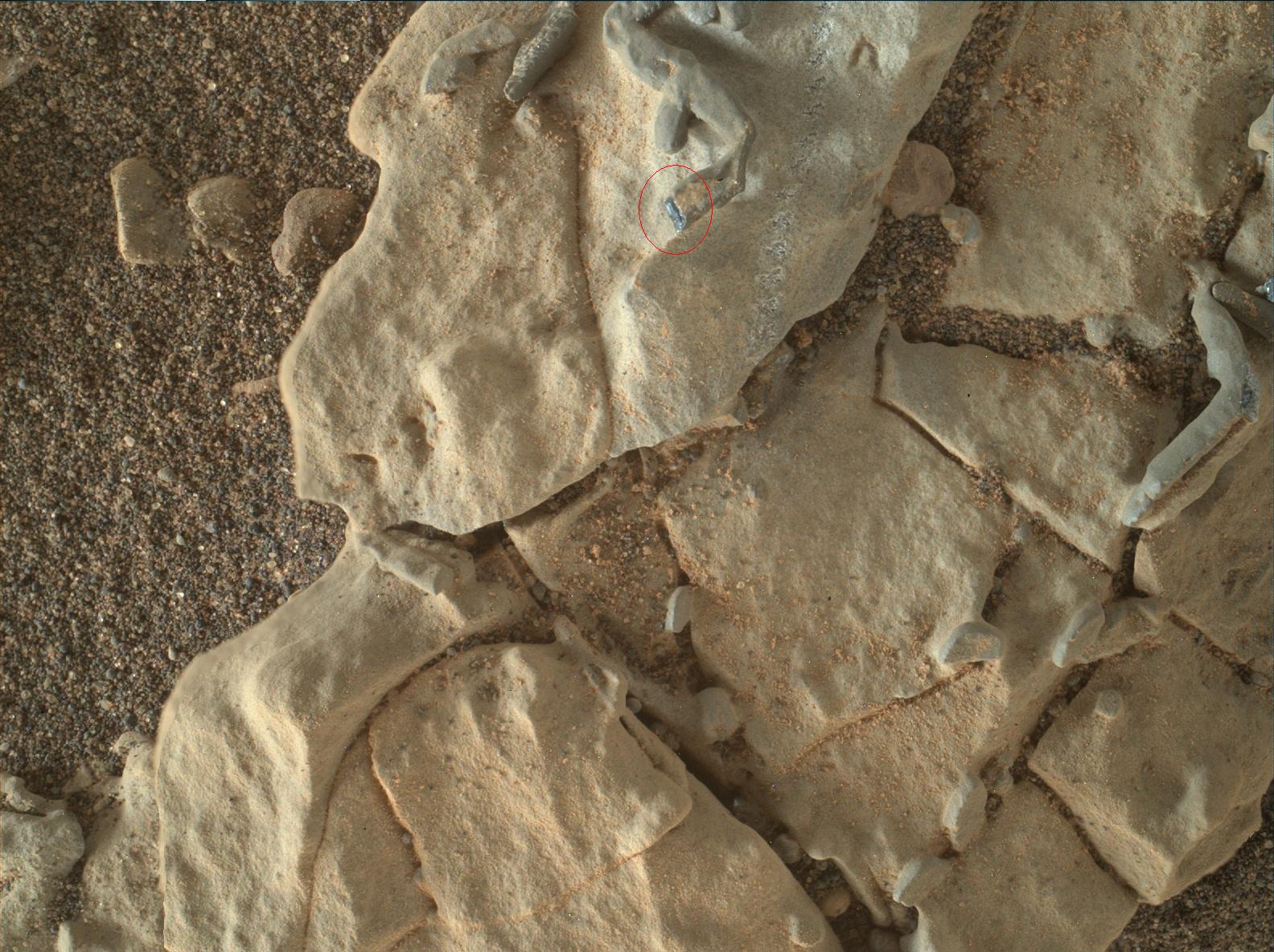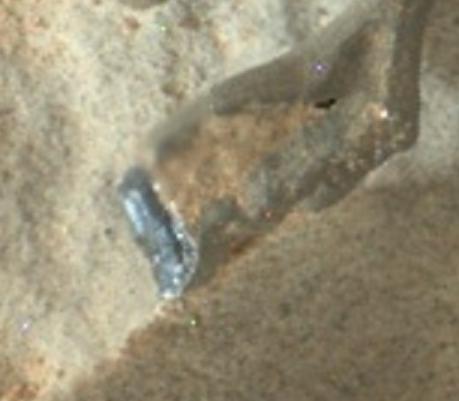It looks like you're using an Ad Blocker.
Please white-list or disable AboveTopSecret.com in your ad-blocking tool.
Thank you.
Some features of ATS will be disabled while you continue to use an ad-blocker.
A Mars Rock to get Excited about , Curiosity Rover Discovers Stick-Like Figures in Mars Rock
page: 3share:
Some of the shapes appear rounded, in cross section. If they were merely geological in origin, why are they rounded? Would veins of crystals in rock
have tubular shapes? Would cracks in rocks, later filled by other minerals, be tubular in shape? I tend to doubt it. Wouldn't they have more or less
random cross-sectional shapes? Tubes like this suggest living things. This seems to be what the biologists are (very cautiously) suggesting.
a reply to: Shadowhawk
LOl The whole cat poo thing reminds me of the Futurama's Katz episode of cats on "Thuban".
LOl The whole cat poo thing reminds me of the Futurama's Katz episode of cats on "Thuban".
originally posted by: underpass61
Man. this part really does look like a flattened lead tube -
now that you pointed it out,,
it does...
Did Curiosity just Snapped that part off! ?
Im guess it did ..
it does look metallic. the Fresh Snap..
if Natural . not sure , if it would be a Metal Vain in rock.
tubing
but it does look like a Bent flat metal Tubing ..
Semi Remelted and Flattened then infused in rock over time
I can now see why NASA went back!
ahh Probley a 500,000 year old Piping from some Alien Outpost on Mars
Apparently ENKI & ENLIL: Left some Traces LOL!!!!!
Disclosure has to come in stages. If these are artifacts, they are temporally distant and are not an immediate threat to fragile psyches. The next
steps are to find newer and newer artifacts until a departing ship is filmed. Then an arriving ship....
When I first saw these a couple of weeks ago, I thought that maybe they were some kind of mud that seeped into a crack and hardened, and then the rest
of the surrounding material eroded away, leaving these things. The most curious part, though was this area, which seems to show a cross-section.

Looks like metal on the inside, probably iron with a thin coat of rust. A melted meteorite?
EDIT: Beat me to it.

Looks like metal on the inside, probably iron with a thin coat of rust. A melted meteorite?
EDIT: Beat me to it.
edit on 10-1-2018 by Blue Shift because: (no reason given)
Curiosity has now returned to "Mcleans Nose" home of the "sticks" , now speculation ends and the science starts.
I'll be keeping an eye on this and will post when results of the analysis becomes available.
while "Mcleans Nose" is a prominent gray toned resistant feature. ChemCam data was acquired of a suite of targets, including those that had the elongate, raised, linear features known by the team as "sticks", as well as the two APXS targets. Documentation imaging of these targets, including multispectral imaging to characterize the visible/near-infrared spectral properties of the site, will happen over the course of the plan.
mars.jpl.nasa.gov... ign
I'll be keeping an eye on this and will post when results of the analysis becomes available.
originally posted by: gortex
Curiosity has now returned to "Mcleans Nose" home of the "sticks" , now speculation ends and the science starts.
Yes, it's very unusual that they drove the rover back to check it out again. That almost never happens, and there have been plenty of things worth taking a second look at IMHO. We'll see what they find out with their laser beams. Here's something they've brushed off. Kind of a Phillips screwdriver head:

edit on 16-1-2018 by Blue Shift because: (no reason given)
Ive seen similar vein like rocks just like this and assumed it was fossilised critter tunnels.
Lake Travis in Austin tx. they are everywhere.
Lake Travis in Austin tx. they are everywhere.
The rover team are now making repeat observations of Macleans Nose following those conducted at the weekend.
Interesting.
In today's plan, we're focusing our attention on small-scale features in the rocks in front of the rover to try and understand how they formed. We have a nice long science block in the early afternoon, during which we'll use ChemCam to assess the targets "Macleans Nose 2," "Funzie 2," and "Ullapool." The targets with "2" in their name are intended to be repeat observations of targets that we analyzed over the weekend to gather additional information.
mars.jpl.nasa.gov...
Interesting.
In a new post about the "stick-shaped features" it seems NASA still haven't determined what they are.
The other possibility is they are fossils but NASA can't bring themselves to say it.
The origin of the stick-shaped features is uncertain. One possibility is that they are erosion-resistant bits of dark material from mineral veins cutting through rocks in this area.
www.jpl.nasa.gov...
The other possibility is they are fossils but NASA can't bring themselves to say it.
a reply to: gortex
Great Find! looks to me like its a metal deposit that the surrounding rock has worn away from. but that's just my op. In the lower left corner of the top figure, you can see an edge that's darker than the rest of the figure, and has what I would consider a metal hue to it, iron deposit may? who knows.
Great Find! looks to me like its a metal deposit that the surrounding rock has worn away from. but that's just my op. In the lower left corner of the top figure, you can see an edge that's darker than the rest of the figure, and has what I would consider a metal hue to it, iron deposit may? who knows.
a reply to: bigfatfurrytexan
Some stuff on Mars does have a bluish tinge, and it's usually metallic/basaltic stuff left over from volcanoes.
Some stuff on Mars does have a bluish tinge, and it's usually metallic/basaltic stuff left over from volcanoes.
originally posted by: bigfatfurrytexan
a reply to: jeep3r
They have a bluish tinge. Did they adjust for true color?
The blueberries all appear to be hematite. These look similar where new edge is exposed
The image posted in the OP shows true mars colors, it's not white-balanced. As you mention, the blueish hue can be seen in some of the hematite-rich areas that were spotted from orbit by MRO and were later imaged up-close on the ground (although hematite itself usually isn't blue in color).
Here's an example:
Color Blend Spherules IM/Pancam imaged by Opportunity rover

And here's the team's latest assessment of the stick shapes imaged by Curiosity:
Tiny Crystal Shapes Get Close Look From Mars Rover
The small, stick-shaped features were first seen two days before Curiosity reached Jura. All raw images from Mars rovers are quickly posted online, and some showing the "sticks" drew news-media attention comparing them to fossils. Among the alternative possibilities is that they are bits of the dark vein material.
The excerpt below sheds some light on how fossils could contain hematite, which under terrestrial conditions forms in aqueous environments:
What Mars Fossils Might Look Like
The minerals surrounding the fossils changed as the sediments cemented to form rock (...) Over time, the minerals altered chemically as well. Rustlike goethite slowly loses hydrogen and oxygen atoms to become more stable hematite over time.
edit on 13-2-2018 by jeep3r because: text
I just read something I missed before and it kinda changed my perspective on this.
These stick shape 'things' are the size of a grain of rice.
Hell, not it could be anything.
These stick shape 'things' are the size of a grain of rice.
Hell, not it could be anything.
originally posted by: StallionDuck
These stick shape 'things' are the size of a grain of rice.
Hell, not it could be anything.
Sure, it's small, but it definitely has a distinct shape and configuration. Grain of rice? Bust open a USB drive and the connections are microscopic.
new topics
-
Inca stone masonry at Sacsayhuaman, Ollantaytambo and the Sun Temple
Ancient & Lost Civilizations: 5 hours ago -
President-Elect TRUMP Picks Former Florida A.G. PAM BONDI to be U.S. Attorney General.
2024 Elections: 9 hours ago -
A Mysterious Orb filmed over NYC by local news
Aliens and UFOs: 10 hours ago -
Putin will warn civilians in targeted areas
World War Three: 11 hours ago
top topics
-
Gaetz withdraws from attorney general consideration
US Political Madness: 16 hours ago, 12 flags -
President-Elect TRUMP Picks Former Florida A.G. PAM BONDI to be U.S. Attorney General.
2024 Elections: 9 hours ago, 12 flags -
Is Russia Using a New Type of Beam Weapon Against Ukraine?
Weaponry: 17 hours ago, 11 flags -
Putin will warn civilians in targeted areas
World War Three: 11 hours ago, 11 flags -
The Popular Vote does not matter
Political Issues: 13 hours ago, 8 flags -
Bridgewater Triangle
General Chit Chat: 16 hours ago, 7 flags -
A Mysterious Orb filmed over NYC by local news
Aliens and UFOs: 10 hours ago, 7 flags -
Inca stone masonry at Sacsayhuaman, Ollantaytambo and the Sun Temple
Ancient & Lost Civilizations: 5 hours ago, 2 flags
active topics
-
All Talk No Walk Celebrities Blowing Smoke
US Political Madness • 57 • : PorkChop96 -
The Popular Vote does not matter
Political Issues • 12 • : AlroyFarms -
Well, here we go red lines crossed Biden gives the go ahead to use long range missiles
World War Three • 323 • : andy06shake -
A Mysterious Orb filmed over NYC by local news
Aliens and UFOs • 7 • : JJproductions -
Former DOJ charged with defrauding Rep. Matt Gaetz’s family over sex-crimes investigation
Propaganda Mill • 43 • : fringeofthefringe -
Casio AT-550 Touch Screen Calculator Watch (1984)
General Chit Chat • 17 • : MadelynnParrish -
Bridgewater Triangle
General Chit Chat • 2 • : billxam1 -
Putin will warn civilians in targeted areas
World War Three • 33 • : RickyD -
Inca stone masonry at Sacsayhuaman, Ollantaytambo and the Sun Temple
Ancient & Lost Civilizations • 1 • : randomtangentsrme -
International Criminal Court Issues Arrest Warrant For Netanyahu
Mainstream News • 39 • : JJproductions


